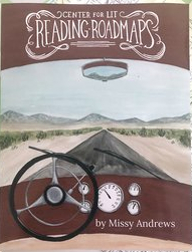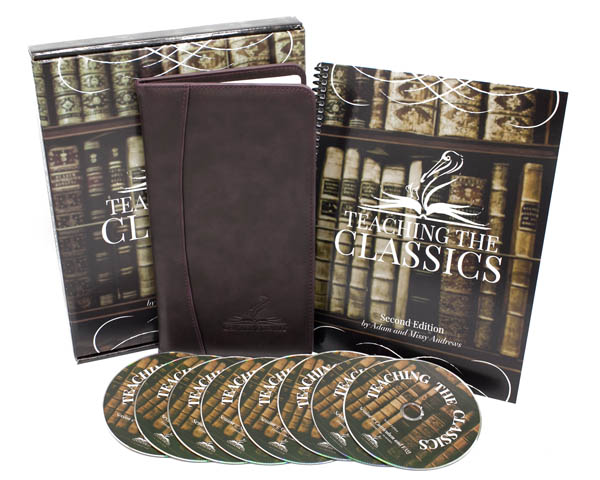Teaching the Classics: A Socratic Method for Literary Education, Second Edition, teaches parents and teachers how to understand and analyze literature using Socratic questioning and discussion. This seminar consists of a book and a set of eight DVDs.
I began my review by reading through the book. Halfway through the book, I began wondering why I would need the DVDs. The book was so well explained and provided concrete models to work with. I expected the DVDs to be redundant. To my surprise, they were not. On the DVDs, Adam Andrews presents a live seminar, covering the material in the book and much more. His goal in the seminar presentation is to ensure that parents and teachers leave feeling competent to apply the methodology themselves. I think he accomplishes this very well while also providing the sort of inspiration that makes you feel like you just can’t wait to try this out.
The DVDs run almost eight hours. I expect you might watch through the entire course, then come back and re-watch sections as you begin to work with the different teaching strategies with your students.
In the first DVD, Andrews lays the foundation for the entire course based upon three principles:
- All works of fiction possess common elements, including Context, Style, and Structure.
- Because of their clarity, children’s stories provide the best opportunities for learning these elements.
- The best classroom technique for presenting and analyzing literature is the Socratic method (Teaching the Classics, p.4).
This approach for tackling literature applies to fiction from the adult level all the way down to children’s storybooks. Since children’s stories are generally easier to work with, Andrews recommends beginning (even with high school students) by analyzing stories written for children.
Three very useful appendices at the back of the book are referenced during the seminar. The first appendix contains “The Socratic List,” an extensive, 13-page list of questions to use for discussions, arranged under broad categories of key questions. Questions are arranged from easier to more challenging levels of difficulty in each category. The teacher should select just a few of these questions to use for each discussion. Appendix B is an annotated, recommended reading list that is cataloged under three levels for young children through high school. Appendix C lists and defines literary devices students will learn to identify such as metaphors, alliterations, and onomatopoeias. A fourth appendix lists additional resources available through the Center for Literary Education.
To help you get started, Andrews uses a number of literary works to demonstrate how to work through different aspects of analysis and discussion. Among his eclectic selections are "Paul Revere's Ride," The Tale of Peter Rabbit, Rikki-Tikki-Tavi, The Adventures of Tom Sawyer, Macbeth, To Kill a Mockingbird, and "Casey at the Bat."
You can teach all types of literature once you’ve gone through this seminar. No other student books need to be purchased other than the literature itself. You might purchase (or borrow) one or more of the Norton Anthologies, Cliff’s Notes, or other resources that will provide you with context and background information for a particular piece. But the reproducible “Story Chart” (for identifying plot, theme, characters, setting, and conflict) and the questions at the back of the Teaching the Classics book provide the rest of your “lesson plan.”
You can begin to have Socratic discussions with younger children, assisting them in completing the Story Chart until they are able to do this on their own. Older students can follow up with essays or papers that further develop a particular topic. Andrews recommends Structure and Style for Students' approach for teaching composition skills. The two programs fit together very well.
The Socratic dialogues generated by this type of learning are effective far beyond the knowledge of literature. They teach children how to think and how to express their thoughts. Within those dialogues, it will be up to the parent or teacher to introduce his or her own worldview perspective. Some of the questions naturally lead into that type of discussion, particularly with certain books. Andrews’ recommended reading list includes a wide variety of books while shying away from current popular literature in favor of more classics that are likely to be great for discussion.
Note: Jill Pike has written A Syllabus for Introduction to Literary Analysis (reviewed at the end of my review of Windows to the World), a course guide that includes teaching instructions for a five-week course using Teaching the Classics. The syllabus will help you present a complete year-long course for high school students using both resources.
Reading Roadmaps
 Many parents have requested more help in selecting literature and identifying themes. So Adam and Missy Andrews have also published Reading Roadmaps: A Literary Scope & Sequence for K-12. In this book, they lay out a number of options that range from daily or weekly literature lessons to seasonal lessons that are taught about four times a year. They identify their top recommendations for literature to be used and chart out plot, conflict, theme, aids/devices (e.g. allusion, parody, epic) for each literary work, arranging them by grade level. They also offer an alternative literary selection for each of the recommended works. Additional helps at the back of the book address writing from literature, learning objectives for each grade level, grading, and the major historical periods for literature with lists of exemplary works and the authors. Reading Roadmaps simplifies the process of using Teaching the Classics by doing some of the work for you.
Many parents have requested more help in selecting literature and identifying themes. So Adam and Missy Andrews have also published Reading Roadmaps: A Literary Scope & Sequence for K-12. In this book, they lay out a number of options that range from daily or weekly literature lessons to seasonal lessons that are taught about four times a year. They identify their top recommendations for literature to be used and chart out plot, conflict, theme, aids/devices (e.g. allusion, parody, epic) for each literary work, arranging them by grade level. They also offer an alternative literary selection for each of the recommended works. Additional helps at the back of the book address writing from literature, learning objectives for each grade level, grading, and the major historical periods for literature with lists of exemplary works and the authors. Reading Roadmaps simplifies the process of using Teaching the Classics by doing some of the work for you.
Ready Readers: Teacher Guides to Socratic Discussion and Worldview Detective
And if that's not enough, the Center for Literary Education also offers Ready Readers that do even more of the work for you. You can teach just about any literary works you want using the format taught in Teaching the Classics. Reading Roadmaps helps you select titles and know the key elements to address. However, some parents prefer more guidance, especially if they tackle literature with which they are not familiar. Ready Readers are teacher's guides for specific collections of books that provide solid guidance for teachers who want to teach literary skills with great literature. See my separate review of Ready Readers.
You might also want to follow up with Worldview Detective which is based on Teaching the Classics methodology.
Summary
Socratic teaching requires more from the parent or teacher than most of the study guides for novels that are popular among homeschoolers. The teacher must read and be familiar with the literary works to be able to lead a discussion.
Once a parent or teacher becomes familiar with the techniques taught by Teaching the Classics, those techniques are likely to become second nature—teaching this way will become easier and easier. And you are likely to enjoy it so much that you won’t mind the extra time it might take.











